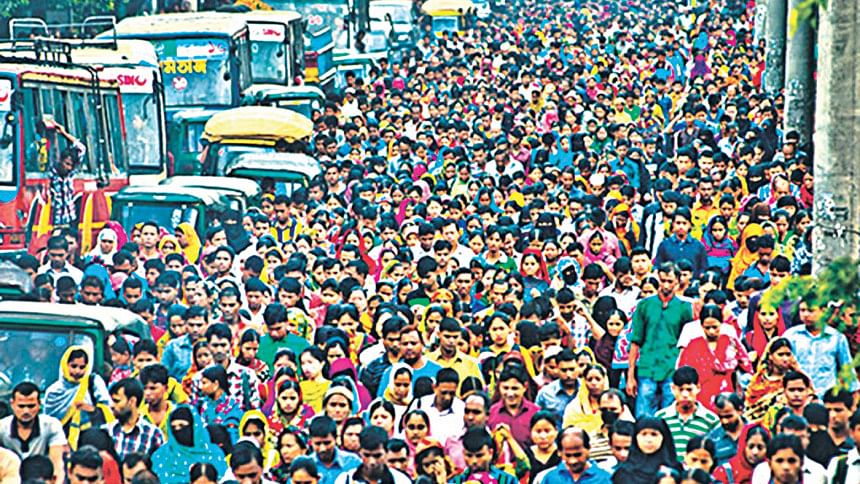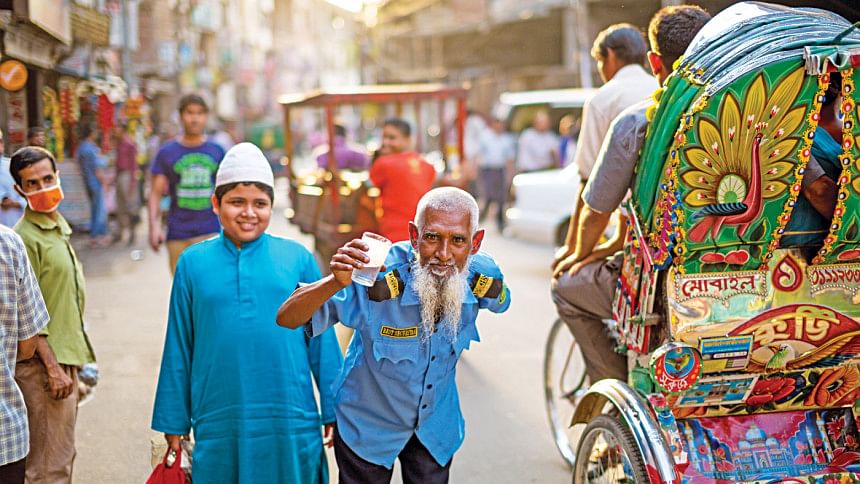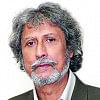Creating a productive workforce for tomorrow

One has to appreciate the fact that Bangabandhu Sheikh Mujibur Rahman identified population boom as the "foremost national problem" for Bangladesh, even though the size of the population was 7.5 crore in the '70s. It amply indicates how farsighted he was in this case as we are burdened with a burgeoning population of over 16 crore today.
The following excerpt from the Bangladesh Population Policy 2012 report released by the Ministry of Health and Family Welfare (GoB), would provide us with an insight into the background that helped in formulating the policy: "The Government has been undertaking various policies with a view to ensuring the constitutional rights for the people of the country. The population growth was identified as the foremost national problem in the first Five Year Plan (1973-1978) of Bangladesh. In this regard the speech delivered by the Father of the Nation Bangabandhu Sheikh Mujibur Rahman in a public meeting held at the historical Suhrawardy Udyan on March 26, 1975 deserves close attention." He said, "My dear brothers, we should not ignore the fact that our population increases by three million every year. On the other hand, the area of our country is only 55,000 square miles. If our population continues to increase at this rate, there would be no cultivable land left in Bangladesh in 25-30 years, and the people of Bangladesh would be reduced to cannibalising each other. That is why it is imperative that we control our population growth through family planning."
Global situation
The UN predicts that 68 percent of world's population would live in cities by 2050. Population growth against shrinking job opportunities has become a cause of concern across continents. Researchers are baffled by the fact that the global population is increasing exponentially, which is expected to increase from 7.9 billion today to 9.1 billion by 2050. Furthermore, the population of the 50 poorest countries would more than double to reach 1.7 billion by then. That means the number of people living in extreme poverty will also rise in frightening proportions.
Some scientists say that it took over 2 million years of human history for the world population to reach 1 billion but only 200 years more to grow to 7 billion.
According to UNFPA, almost all of the net increase in population is occurring in developing countries, and in many of them, the number of people living in poverty is rising.
It has been established through research that burgeoning population and poverty are intricately related. According to World Bank, about 9.2 percent of the world, or 689 million people, live in extreme poverty on less than USD 1.90 a day. Another study says that 2.7 billion struggle to survive on less than USD 2 a day. Around 852 million people are chronically or acutely malnourished, some 300 million of them children.
Research also reveals that the countries where poverty levels are the highest are generally those that have the most rapid increases in population.
The 2020 census showed that China's population reached the expected level of 1.41 billion people and it continues to grow. After the one-child policy of 1979, Chinese authorities announced the loosening of family-planning rules, so that couples can have three children, rather than two. They are now planning for a comprehensive plan for boosting the fertility rate.

But it needs to be said here that when China allowed eligible couples to have two children instead of one, the rural couples grabbed the opportunity, as they needed more hands to help in the farms, but most urban couples showed least interest in taking a second child. They do not have the time or energy to raise another child after doing a 9 to late afternoon job that demands hard work.
Since the two-child policy came into effect, in early 2016, the number of births rose by 7.9 percent year-on-year, the highest increase since 2000, according to China's National Health Commission.
India is the second most populated country in the world with nearly a fifth of the world's population. In January 2022, India's population reached 1.41 billion. Demographers project India to surpass China to become the world's most populous country by 2024.
The story of population growth and family planning programme coming from Iran is an interesting one. Research data show that while Iran's population grew at a rate of more than 3 percent per year between 1956 and 1986, the growth rate began to decline in the late 1980s and early 1990s thanks to the Ayatollah Khomeini's support for a major population control programme. By 2007 the growth rate had declined to 0.7 percent per year. The projected level for Iran's 2005 to 2010 birth rate is fewer than two.
But, in July 2012, Supreme Leader Ali Khamenei described Iran's contraceptive services as "wrong," and as a result, Iranian authorities are slashing birth-control programmes. So, we shall have to wait to see where this policy reversal takes its population to.
The situation in Bangladesh
The current population size of Bangladesh is 167,140,078. According to various authentic sources, the population growth rate decreased over the last 60 years, peaking at 3.23 percent in 1967 to the present 1 percent. Though the growth rate has decreased, the population continues to grow making Bangladesh one of the most populated countries in the world. It is also one of the most densely populated countries in the world.
Experts identified low contraception use, child marriage, and high total and adolescent fertility rates as among the main reasons for the increase. Currently, the birth rate in Bangladesh is 17.88 births per 1,000 people and the death rate is about 4.8 deaths per 1,000 people.
Research studies show that through the 1960s and 1970s, the birth rate in Bangladesh was among the highest in the world but it started to come down considerably in the 1980s. The fertility rate now stands at 2.4 children born per woman.
Bangladesh is expected to reach a population of 186 million by 2030, who will be living within 147,570 square kilometres or 56,980 square miles. Unless this huge population is turned into a resource, Bangladesh will have to face various kinds of socio-economic problems in the future.
Way out
What is the way out? How can we contain the growth and at the same time turn this huge population into a resource? Experts say there is no single magic bullet. Rather, a number of steps will have to be taken concertedly by the government and non-government actors to stem the growth and turn the population into a productive workforce. Stopping child marriage and increasing the age of marriage are two steps that can be emphasised to begin with.
Experts suggest that the eligible couples in the country will need to be encouraged through family planning institutions to use family planning methods, especially long-term contraception methods after the birth of the second child. The concept of birth spacing to ensure good health of the mother has to be instilled into both the female and male members of the family.
If the age and health of the new bride is vulnerable, then the couple should be advised to delay in taking the first child through adopting family planning. Health experts advise that fewer pregnancies lead to lower maternal mortality and morbidity.
Girls must be allowed to complete school education and sit for the SSC examination. Education empowers women. Studies show that as women become more educated, they tend to have fewer children, and participate more in income generating activities. Families with lower fertility rates are better able to invest in the health and education of each child.
Conclusion
Bangladesh's population experts and policymakers will have to look deep into the problem of the huge population and formulate pragmatic policies so that men and women can be turned into resources. Give them education, family planning advice and life-skill training to become worthy citizens. Otherwise, in the numerous slums and fringes, birth will have no purpose, just as much as death will have no profound meaning.
Shahnoor Wahid is a senior journalist.

 For all latest news, follow The Daily Star's Google News channel.
For all latest news, follow The Daily Star's Google News channel. 



Comments